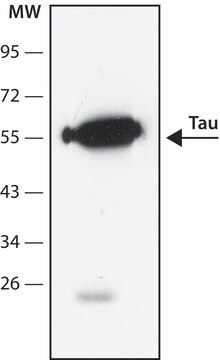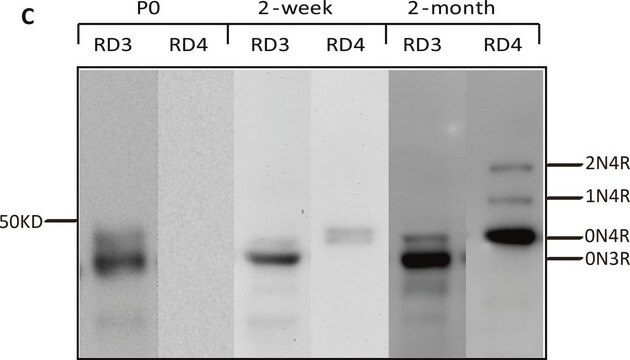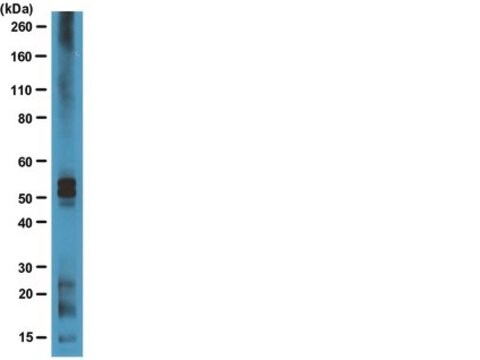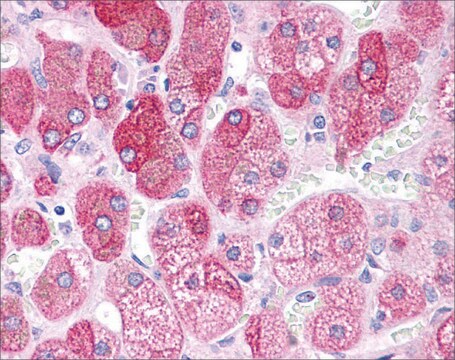ABN454
Anti-Tau (T22), oligomeric Antibody
serum, from rabbit
Sinônimo(s):
Microtubule-associated protein tau oligomer, Tau oligomer, PHF-tau oligomer, Paired helical filament-tau oligomer, Neurofibrillary tangle protein oligomer
About This Item
Produtos recomendados
fonte biológica
rabbit
Nível de qualidade
forma do anticorpo
serum
tipo de produto de anticorpo
primary antibodies
clone
polyclonal
reatividade de espécies
human
técnica(s)
ELISA: suitable
dot blot: suitable
immunofluorescence: suitable
immunohistochemistry: suitable
immunoprecipitation (IP): suitable
neutralization: suitable
western blot: suitable
nº de adesão NCBI
nº de adesão UniProt
Condições de expedição
wet ice
modificação pós-traducional do alvo
unmodified
Informações sobre genes
human ... MAPT(4137)
Descrição geral
Especificidade
Imunogênio
Aplicação
Immunohistochemistry Analysis: A 1:245-1,000 dilution from a representative lot detected tau oligomers in frontal cortices from Alzheimer′s Diseased (AD) and Lewy Body Diseased (LBD) patients (Courtesy of Prof. Rakez Kayed, University of Texas, Galveston).
Immunofluorescence Analysis: A representative lot detected oligomeric tau in chronic traumatic encephalopathy (CTE) brain tissue sections, while little or no tau oligomer immunoreactivity was seen in non-CTE human brain sections. The tau oligomer immunoreactivity colocalized with that of tau pThr231 with a cis conformation, but not tau pThr231 with a trans conformation, between pThr231 and Pro232 (Kondo, A., et al. (2015). Nature. 523(7561):431-436).
Immunofluorescence Analysis: A representative lot detected oligomeric tau immunoreactivity in paraffin-embedded frontal cortex sections from Alzheimer′s diseased (AD) brains (Lasagna-Reeves, C. A., et al. (2012). FASEB J. 26(5):1946-1959).
Western Blotting Analysis: A 1:1,000 dilution from a representative lot detected oligomeric tau in chronic traumatic encephalopathy (CTE) in Tau Aggregate lysate.
Western Blotting Analysis: Representative lots detected oligomeric tau, but not monomeric tau, or any other oligomeric and fibrillar proteins (Wu J.W., et al. (2013). J. Biol. Chem. 288(3):1856-1870; Lasagna-Reeves, C. A., et al. (2012). FASEB J. 26(5):1946-1959).
Dot Blot Analysis: A representative lot detected tau oligomers, but not tau monomer or paired helical filaments (PHFs) (Lasagna-Reeves, C. A., et al. (2012). FASEB J. 26(5):1946-1959).
ELISA Analysis: Representative lots detected vitro formed tau oligomers as well as tau oligomers in PBS-soluble brain extracts from progressive supranuclear palsy (PSP) patients (Lasagna-Reeves, C.A., et al. (2012). Sci. Rep. 2:700; Lasagna-Reeves, C. A., et al. (2012). FASEB J. 26(5):1946-1959).
ELISA Analysis: A representative lot showed selective reactivity toward oligomeric tau, while exhibiting greatly reduced immunoreactivity toward tau fibrils, and no reactivity toward monomeric tau, or other protein oligomers or fibrils (e.g., Aβ, α-synuclein, or islet amyloid polypeptide) (Lasagna-Reeves, C. A., et al. (2012). FASEB J. 26(5):1946-1959).
Immunoprecipitation Analysis: Representative lots immunoprecipitated oligomeric tau from Alzheimer′s Diseased (AD), but not non-AD brains (Lasagna-Reeves, C.A., et al. (2012). Sci. Rep. 2:700; Lasagna-Reeves, C. A., et al. (2012). FASEB J. 26(5):1946-1959).
Neutralizing Analysis: Representative lots neutralized oligomeric tau toxicity to SH-SY5Y human neuroblastoma cells (Lasagna-Reeves, C.A., et al. (2012). Sci. Rep. 2:700; Lasagna-Reeves, C. A., et al. (2012). FASEB J. 26(5):1946-1959).
Immunohistochemistry Analysis: A representative lot detected oligomeric tau immunoreactivity in paraffin-embedded brain sections from progressive supranuclear palsy (PSP) patients (Lasagna-Reeves, C. A., et al. (2012). FASEB J. 26(5):1946-1959).
Neuroscience
Neurodegenerative Diseases
Qualidade
Western Blotting Analysis: A 1:1,000 dilution of this antibody detected tau oligomers in Alzheimer′s diseased (AD), but not non-AD, human brain tissue lysate.
Descrição-alvo
forma física
Armazenamento e estabilidade
Handling Recommendations: Upon receipt and prior to removing the cap, centrifuge the vial and gently mix the solution. Aliquot into microcentrifuge tubes and store at -20°C. Avoid repeated freeze/thaw cycles, which may damage IgG and affect product performance.
Exoneração de responsabilidade
Não está encontrando o produto certo?
Experimente o nosso Ferramenta de seleção de produtos.
Código de classe de armazenamento
10 - Combustible liquids
Classe de risco de água (WGK)
WGK 1
Certificados de análise (COA)
Busque Certificados de análise (COA) digitando o Número do Lote do produto. Os números de lote e remessa podem ser encontrados no rótulo de um produto após a palavra “Lot” ou “Batch”.
Já possui este produto?
Encontre a documentação dos produtos que você adquiriu recentemente na biblioteca de documentos.
Nossa equipe de cientistas tem experiência em todas as áreas de pesquisa, incluindo Life Sciences, ciência de materiais, síntese química, cromatografia, química analítica e muitas outras.
Entre em contato com a assistência técnica





